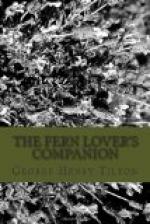fertile
fronds are unlike the sterile.
EMARGINATE. Notched at the apex.
ENTIRE. Without divisions, lobes, or teeth.
FALCATE. Scythe-shaped, slightly curved upward.
FERTILE. Bearing spores.
FILIFORM. Thread-like; long, slender, and terete.
FILMY. Having a thin membrane; gauzy;
said of the filmy fern fronds.
FLABELLATE. Fan-shaped; broad and rounded at
the summit and narrow at the base.
FROND. A fern leaf or blade; may include
both stipe and blade, or only the
latter—called also lamina.
GLABROUS. Smooth; not rough or hairy.
GLAND. A small secreting organ, globular or
pear-shaped; it is often stalked.
GLAUCOUS. Covered with a fine bloom, bluish-white
and powdery, in appearance
like a plum.
HASTATE. Like an arrowhead with the lobes
spreading.
IMBRICATE. Overlapping, like shingles on a roof.
INCISED. Cut irregularly into sharp lobes.
INDUSIUM. The thin membrane covering the
sori in some ferns.
INVOLUCRE. In ferns, an indusium; in filmy
ferns, cup-shaped growths encircling
the sporangia.
LAMINA. A blade; the leafy portion of a fern.
LACINIATE. Slashed; cut into narrow, irregular
lobes.
LANCEOLATE. Lance-shaped; broadest above the
base and tapering to the apex.
LOBE. A small rounded segment of a frond.
MIDRIB. The main rib or vein of a segment,
pinnule, pinna, or frond; a midvein.
MUCRONATE. Ending abruptly in a short, sharp
point.
OBLONG. From two to four times longer than
broad and with sides nearly parallel.
OBTUSE. Blunt or rounded at the end.
OIDES. A Greek ending, meaning like, or
like to, as polypodioides—like to a
polypody.
OOeSPHERE. The egg-cell in fern reproduction—becoming
the ooespore when fertilized.
OVATE. Egg-shaped with the broader end
downward.
PALMATE. Having lobes radiating like the
fingers of a hand.
PANICLE. A loose compound cluster of flowers
or sporangia with irregular stems.
PEDICEL. A tiny stalk, especially the stalk of
the sporangia.
PELLUCID. Clear, transparent.
PERSISTENT. Remaining on the plant for a long
time, as leaves through the winter.
PETIOLE. The same as stalk or stipe.
PINNA. One of the primary divisions of a frond.
PINNATE. Feather-like; with the divisions of
the frond extending fully to the rachis.
EMARGINATE. Notched at the apex.
ENTIRE. Without divisions, lobes, or teeth.
FALCATE. Scythe-shaped, slightly curved upward.
FERTILE. Bearing spores.
FILIFORM. Thread-like; long, slender, and terete.
FILMY. Having a thin membrane; gauzy;
said of the filmy fern fronds.
FLABELLATE. Fan-shaped; broad and rounded at
the summit and narrow at the base.
FROND. A fern leaf or blade; may include
both stipe and blade, or only the
latter—called also lamina.
GLABROUS. Smooth; not rough or hairy.
GLAND. A small secreting organ, globular or
pear-shaped; it is often stalked.
GLAUCOUS. Covered with a fine bloom, bluish-white
and powdery, in appearance
like a plum.
HASTATE. Like an arrowhead with the lobes
spreading.
IMBRICATE. Overlapping, like shingles on a roof.
INCISED. Cut irregularly into sharp lobes.
INDUSIUM. The thin membrane covering the
sori in some ferns.
INVOLUCRE. In ferns, an indusium; in filmy
ferns, cup-shaped growths encircling
the sporangia.
LAMINA. A blade; the leafy portion of a fern.
LACINIATE. Slashed; cut into narrow, irregular
lobes.
LANCEOLATE. Lance-shaped; broadest above the
base and tapering to the apex.
LOBE. A small rounded segment of a frond.
MIDRIB. The main rib or vein of a segment,
pinnule, pinna, or frond; a midvein.
MUCRONATE. Ending abruptly in a short, sharp
point.
OBLONG. From two to four times longer than
broad and with sides nearly parallel.
OBTUSE. Blunt or rounded at the end.
OIDES. A Greek ending, meaning like, or
like to, as polypodioides—like to a
polypody.
OOeSPHERE. The egg-cell in fern reproduction—becoming
the ooespore when fertilized.
OVATE. Egg-shaped with the broader end
downward.
PALMATE. Having lobes radiating like the
fingers of a hand.
PANICLE. A loose compound cluster of flowers
or sporangia with irregular stems.
PEDICEL. A tiny stalk, especially the stalk of
the sporangia.
PELLUCID. Clear, transparent.
PERSISTENT. Remaining on the plant for a long
time, as leaves through the winter.
PETIOLE. The same as stalk or stipe.
PINNA. One of the primary divisions of a frond.
PINNATE. Feather-like; with the divisions of
the frond extending fully to the rachis.




